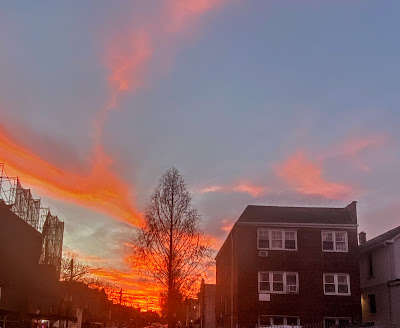 |
| The Gloaming As Seen from 37th Avenue in Queens Looking Southwest |
Words to Describe the Period of Sunset
In the English language there are a few words that can be used to describe that moment between day and night. The most common word is dusk — which I feel like is a broad term to describe that temporal zone in which the sun has dipped below the horizon but a sliver of light remains.
It is part of the larger sunset process, that process seen from an observer on Earth as the day and night cycle. The sun seems to dip below the horizon line, never to be seen again. Our ancestors hoped for another new day — and especially in Wintertime, as the sunlight grows less during the day, we pine for more light — hence the origin of almost every Winter holiday celebration from Diwali, to Hannukah and Kwanzaa, and to Christmas. We look and pray for the restoration of light.
Twilight or Gloaming?
Twilight — which is closer to what the term gloaming means. It is that precious moment where the last dots of lights appear in a reddish, bronze haze of light — and then slowly descend into night.
I imagine gloaming is the more poetic term. Twilight is reserved the scientific view of the event. Read this nice article from the British newspaper The Guardian for a thorough review of the different terms.
I like this time of day — while it is just as likely to capture a similar picture in the morning, when in reverse, we see a similar process in the dawn.
When have you seen a gorgeous dusk? What do you call it?

No comments:
Post a Comment
Be courteous. Speak your mind. Don’t be rude. Share.